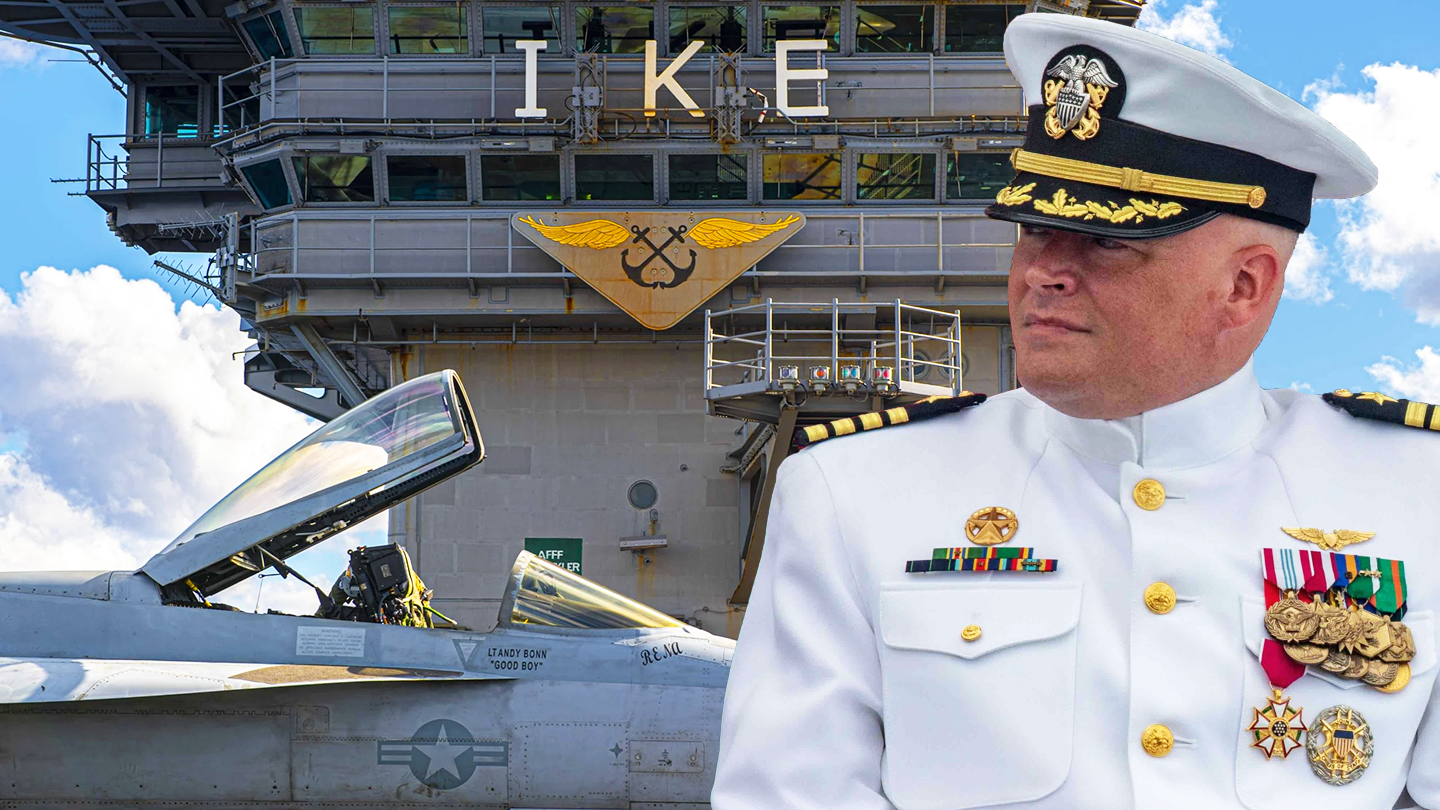Navy Capt. Christopher “Chowdah” Hill commands the Nimitz class aircraft carrier Dwight D. Eisenhower which recently returned from the Middle East. The historic, nine-month deployment saw the ship and its escorts under fire from an array of weapons old and new and ended up being one of the most dangerous and grueling the sea service has experienced since the Korean War. Now the combat-proven skipper opened up to TWZ like never before about what being under constant threat of attack was like and the rapidly changing tactical realities he and thousands of his sailors faced while plowing the waters of the Red Sea and Gulf of Aden.
The Eisenhower Carrier Strike Group (IKECSG) was called into the region following the Oct. 7 surprise Hamas attack on Israel. Once there, they battled Houthi rebels repeatedly attacking them and commercial shipping off Yemen’s shores. Collectively, the IKECSG used its various weapons to destroy a bevy of Houthi aerial drones, missiles, uncrewed surface vessels, and undersea vehicles, and different kinds of targets ashore, firing nearly 800 missiles and other munitions in the process. They also helped defend Israel from the first-ever direct attack from Iran.
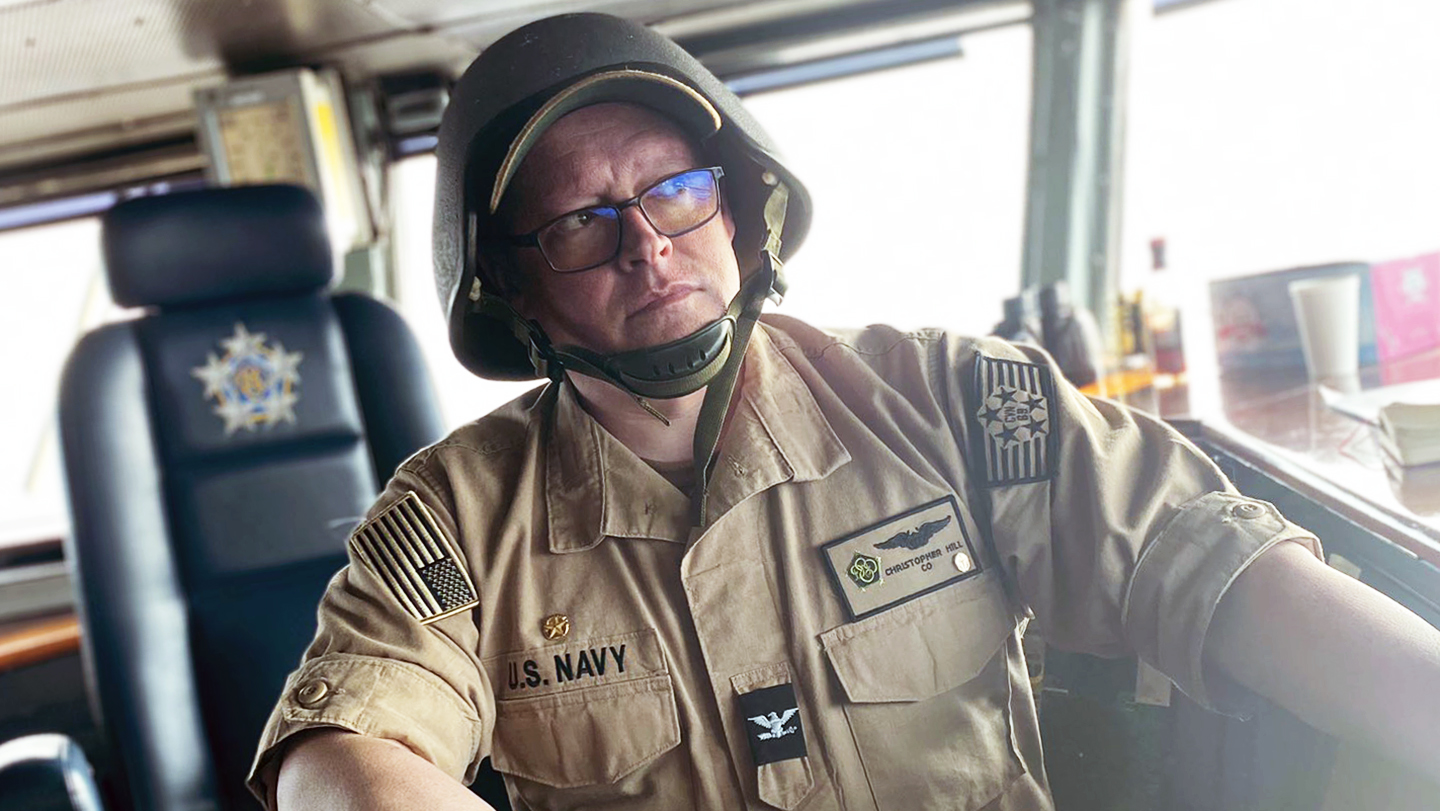
The Eisenhower and the vessels in the carrier strike group experienced a remarkable number of other firsts.
A U.S. Navy EA-18G Growler electronic warfare jet deployed to the flattop claimed the type’s first air-to-air kill, likely downing a Houthi drone. Growlers from Ike’s air wing also employed AGM-88E Advanced Anti-Radiation Guided Missiles (AARGM) for the first time in combat in the course of those operations, including in a strike that destroyed an Mi-24/35 Hind gunship helicopter on the ground that The War Zone was first to confirm. An Arleigh Burke class destroyer attached to the carrier strike group fired the Navy’s newest missiles in combat for the first time. An F/A-18F Super Hornet pilot assigned to the Ike became the first woman in U.S. military history to score an air-to-air kill. It was also the first time anti-ship ballistic missiles were used in combat, a challenging threat Ike and its escorts had to confront on a regular basis.
Here is our in-depth exchange with Hill — a Quincy, Massachusetts native and former E-2C Hawkeye flight officer. Some questions and answers have been slightly edited for brevity and clarity.
Everything Changed Oct. 7
Q: How much was the Middle East on your radar as a major contingency leading up to your cruise and what was it like on Oct. 7th [when Hamas attacked in Israel]? Did you realize everything for your crew was about to change?
A: Prior to Oct. 7th, the crew was pretty excited about a potential port call, multiple port calls to the Mediterranean and the North Sea. We were going to do NATO exercises. Everybody was super pumped about that. And this was important for the crew because prior to that, they had done two back-to-back deployments in 2020 and 2021. So it was a lot of excitement, but again, that all changed on Oct. 7th. Hamas invades Israel, and then we go ahead and deploy a week later. We didn’t really have a mission right away, other than to make best speed to the eastern Med, meet up with the [aircraft carrier USS Gerald R. Ford], take some pictures, provide some presence operations to deter countries around Israel during that time. So it was a big flip. And the thing is, when we go through our workup training, we’re doing a lot of preparation for pretty much anything. We don’t really focus on specific threats each time. We focus it on more of a generic threat because we know that when we get out there, it could be anything. And in this case, it was something. So that’s kind of our approach to it.
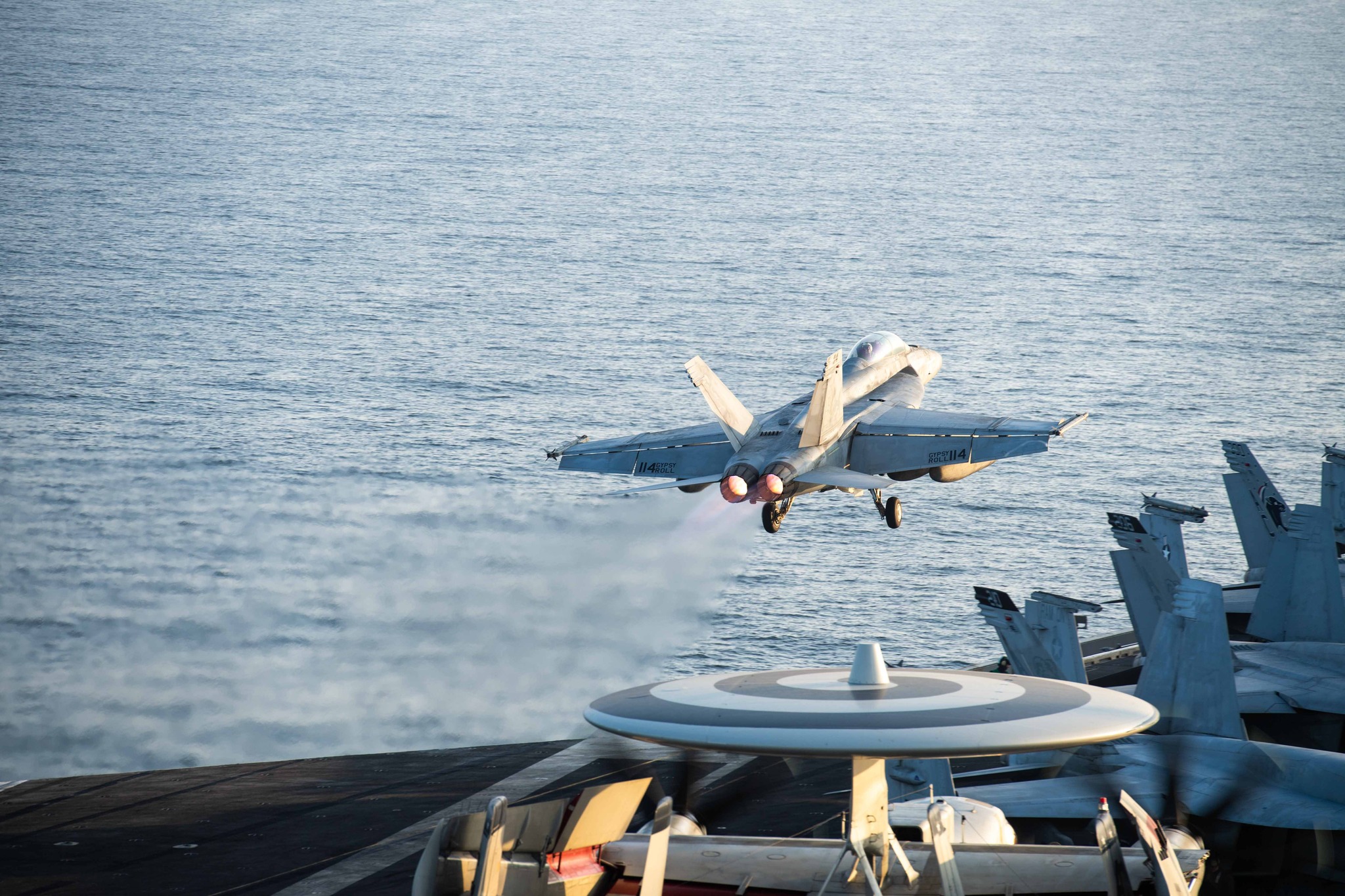
Q: How did the mood on the ship change when you arrived in a very hot free-fire zone where ships are being attacked left and right? This was very obviously unlike anything the Navy has confronted in a long time. What was that like?
A: You know, I haven’t been asked that question, but kind of an interesting thing happened. So we had been talking about the potential for going to war, it’s just what we do when we’re doing workups, and it’s built into our mission and vision statements. And so we went ahead and actually ended up doing that. And I would talk to the crew almost every day and remind them, because a lot of them – a couple of thousand – it was probably their first tour. I kept saying, ‘hey, this is not normal. What we’re doing, this is unprecedented, and everybody here should be so proud of what you’re doing.’ But it’s not something the Navy has done in modern history as far as we know.
Q: So that was quite a revelation I imagine.
A: Oh, yeah. It was just an interesting response, but the fact that I had to keep reminding them that we have a mission and purpose in this theater, our job was to deter or degrade the capability of the enemy. And we were doing just that and reminding people that they were part of that. And that’s important for maintaining morale in difficult situations like that. We didn’t have many port calls. We had two towards the end, so there’d been more than six months before the sailors were really allowed to get off the ship. And that’s happened before historically, but it’s still tough. Morale is super important. It’s what leads to success. We got to see success from our perspective at the micro-tactical level. And the sailors did a super job.

Q: As good as the U.S. Navy’s defenses are, there had to be a real worry that a drone or a missile might leak through. What was it like commanding a ship moment-to-moment, knowing there was an opposing force with throngs of drones and anti-ship missiles who really wanted to sink your ship and those in your strike group?
A: Well you have to live your life. You can’t obsess about these things. But we put measures in place. Everything from the ISR intelligence – surveillance, reconnaissance – be able to detect things early enough, station ourselves so there’s plenty of time to react, defense-in-depth built-in with multiple ships in the strike group defending themselves and the aircraft carrier. And then being on an aircraft carrier, when you have plenty of warning, you can launch aircraft. And we’ve launched multiple alert aircraft to respond to threats. And it just became, at some point, routine.
Q: Routine, really?
A: Yeah, you kinda have to make it routine because if you’re living in sort of an extremis situation, a lot of that’s your own doing, right? So you have to set up the manning. When people are sleeping, make sure they have circadian-friendly watch rotations. They have normal days. So I would carefully worry about the manning on the flight deck, so people get adequate sleep. And we got better. We learned over time to massage that, so that we could respond to any threat. And again, it became fairly routine and they were good at it. But again, this is stuff that we had practiced prior to deployment during our composite unit training exercise, which is sort of our capstone event to certify us for deployment. And that’s like a five- to six-week evolution. All carrier strike groups go through it, and it’s pretty intense.
Q: Did the air wing already prepare for major drone barrages before the cruise, or really adapt on the fly? Were you praciticing to deal with the drone barrages?
A: That’s probably something I can’t answer right now.
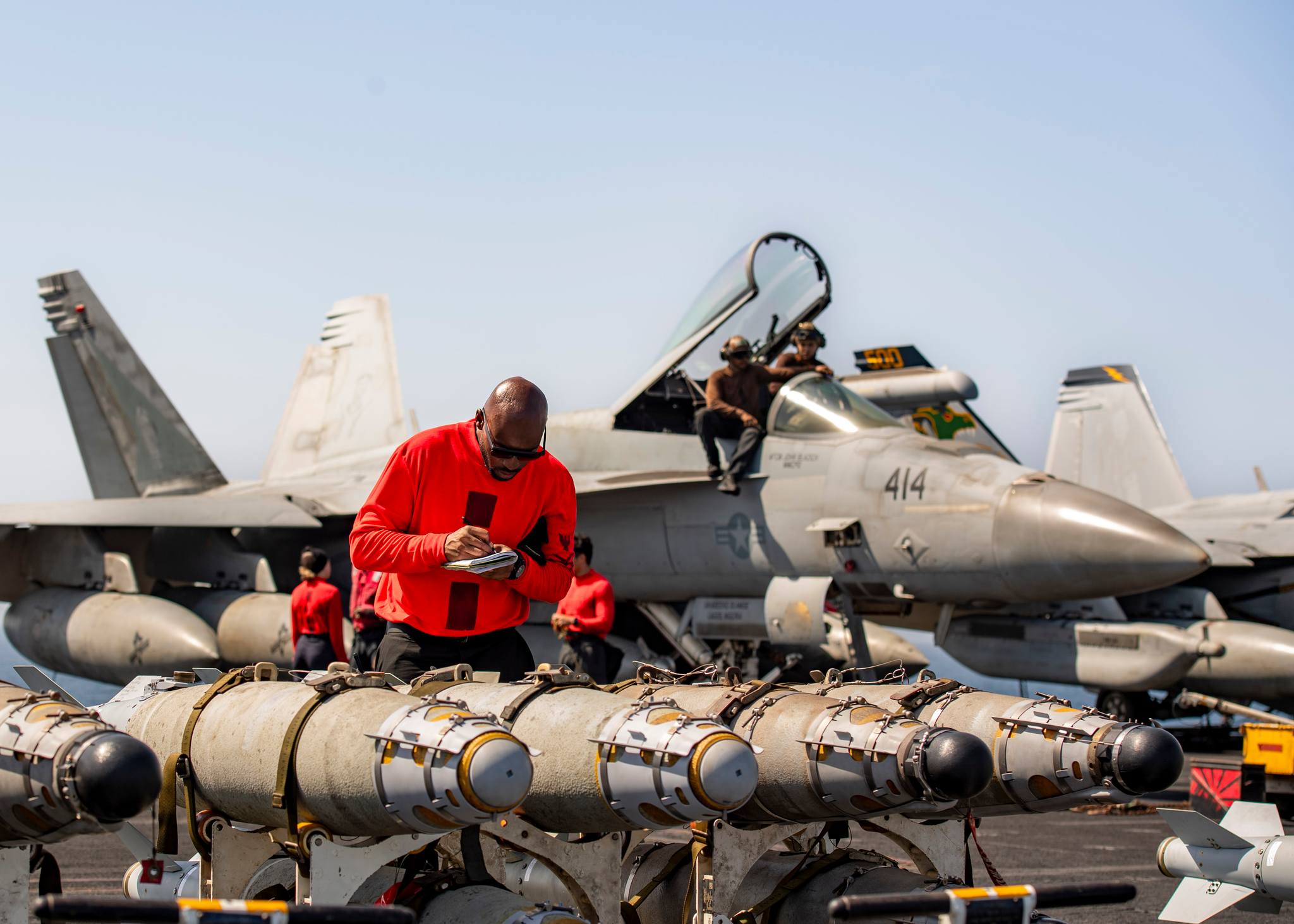
Q: What’s the big takeaway from dealing with lots of aerial kamikaze drones and drone boats?
A: Some people would say it’s a step up in technology. I don’t think of it that way. It’s still a vehicle that’s weaponized, whether it’s a surface vessel or an air vehicle. It just doesn’t have somebody driving it. Where this provides advantages potentially is the entire network that helps control those vessels. So, you’re not essentially going after just the target. There are other targets associated with it, right? So you can look at it differently in that sense. It brings about its own vulnerabilities, and the other part of it is these things are going rather slowly, so it makes it easier.
Q: Did you see any advancement in the Houthi aerial or sea drone capabilities? Did you see any kind of iterative developments?
A: Yeah, that’s one of those things I can’t really answer, sorry.
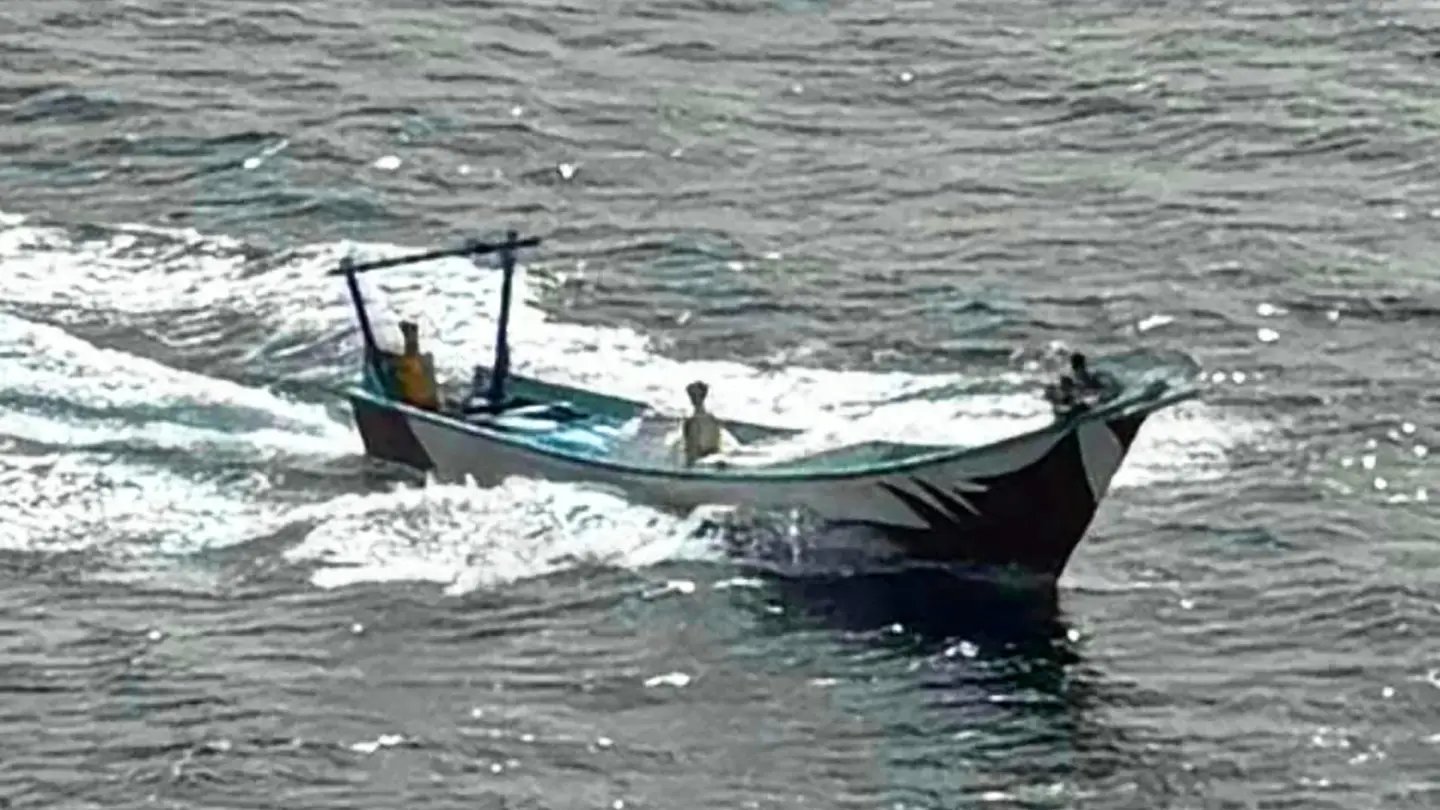
Q: Was the first shoot down by a Super Hornet an eye-opener? How many did they take down in all?
A: I know there were several dozen shot down by fighter jets. It was not an eye-opener. It was expected, so we knew that eventually, it would happen. So we prepared for it, and then the fighters started executing and they did a superb job.
Q: We saw a new air-to-air missile loadout configuration rushed into service to address this threat. Can you talk a little about how that came about and was subsequently put into play?
A: That’s probably one I can’t answer. But what I can say is anytime there’s a different type of threat out there, we change the configuration of what we load on aircraft, right? And it makes sense. If you’re gonna go after surface vessels, you’re gonna need certain air-to-ground ordnance. Different types of air-to-air threats, you’re gonna put on different ordnance. So that’s pretty easy for us to adapt in just a few hours we can make those changes.
Q: Do you need permission from a higher headquarters to use new weaponry or is that something you can do on the fly?
A: If you’re gonna do something that’s brand new, you’d need to get approved by one of the what do they call it? Yeah. See, this is not my area, but you basically get an in-flight change approved from an offsite organization in the Navy to make sure it would actually work.

Flying In A Hawkeye
Q: So you’re an E-2 Hawkeye guy. The Screwtops on Ike‘s air wing were among the last squadrons flying the C model over the vastly improved D model. They had to be essential players in the defense of the carrier strike group, and pretty much everything else in the region. Can you talk about some feats they pulled off despite their aging systems?
A: The Hawkeye – no matter what grade or variant and how old it is – its secret weapon is actually the people inside it and their ability to talk on the radio. So you have multiple radios on the aircraft. They go out there and they sort out the situation so that they can make fires more efficient, right? This is something that we’ve been doing in the Hawkeye community back to the late ’60s. And it hasn’t evolved a lot, but the technology has evolved, certainly. The Hawkeye also becomes sort of an intel node where it’s getting a lot of information that it can feed to the fighters to affect the target in a more rapid fashion. So even the E-2C Hawkeye 2000, which the Screwtops had, was very capable on that front. So not only do they have the radios, they have the radar, they have the intel feeds, they can kind of put that all together, put it into a fighter cockpit, and make something happen. And the Screwtops are doing that literally every single day. And I got to fly with them about once a week and get to see it myself.
Q: What was that like?
A: Oh, it was great. The operations became fairly routine and they would just say, ‘here you go, sir. You can control the aircraft.’ And so I would talk on the radio and I was probably at 50% of my original capability, ’cause the last time I flew seriously was 10 years ago. But I fumbled through it and we got the job done.
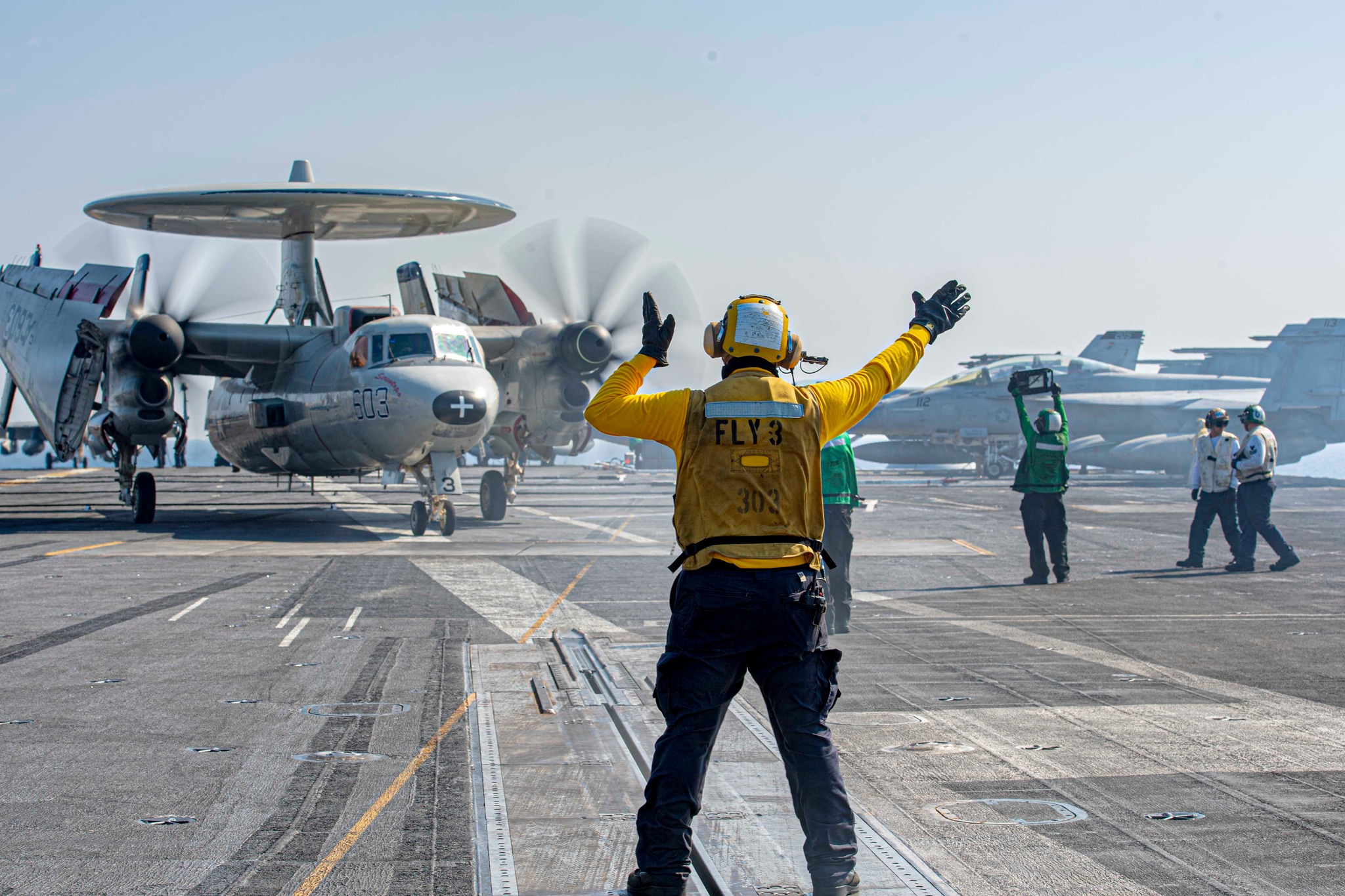
Q: What was the most challenging thing you experienced while you were up there?
A: There weren’t too many challenging things, but it was frequently very busy, and getting to work with the fighters and pass them targets to destroy, I got to do that. And that, again, was a fairly routine thing that the Hawkeye guys were doing quite frequently.
Q: How many carrier skippers get to do that?
A: Every carrier skipper has the opportunity to do it but it depends on what platform they’re comfortable with. So, for instance, a Hornet pilot might want to fly the Hornet. The previous XO that we had flew in the Hornet as well, and I could fly in the Hornet. I did a lot of flights in the F-18 and a few in the Growler as well, just to kind of mix it up, but I was most comfortable in the platform that I flew for almost 20 years. So towards the end, I just flew in the Hawkeye every week.
Q: Can you talk about any of the targets that you were involved in taking out?
A: Just in general, I could say that the targets were surface vessels, unmanned aerial vehicles, surface-to-air missile systems, enemy radars, anytime they had missiles queuing up, that kind of stuff. Pretty much the standard targets that you would have in this situation. So trying to get after things before they actually get airborne.
Q: What was it like when you saw the results?
A: Eh, just doing the job, right? So a little bit of pride, a little bit like ‘you got the job done, you were supporting the mission.’ So it provides purpose. The mission was to degrade their capability. And then if you put more thought into it, what we were doing was saving other people’s lives, including Navy sailors, but merchant mariners as well. So to me, that was sort of like the implied or unstated mission, and it was something we took a lot of pride in.
Toward the end, we had a few instances where we got to rescue people who had been attacked by Houthis. And that brought a lot of joy and pride to the Strike Group to be involved in those operations. One of them involved the Motor Vessel Tudor. When they started sinking, the [cruiser] Philippine Sea rescued 25 Filipinos, kind of ironic there, and brought them aboard, brought ‘them to the Ike, and then we got to take care of them. And the best part about it is how the sailors on their own got together and said, ‘Hey, we’re gonna take care of these merchant mariners, ’cause they just had a tough time. They lost one of their own.’ And when I came down to visit them, they were singing songs in Tagalog, because we have quite incredible diversity throughout the Navy that we can do things like that. We actually rescued an Indian mariner who speaks, if I get this right, I think it’s Hindi and/or Hindu. I always screw those two up. But we found a sailor who could speak it, and I kept saying, well, how do you know she can actually speak it? Because I wanted someone to do some more thorough translation. And they said, ‘well, she was on her phone with her husband arguing with him for 30 minutes. We’re pretty sure she could speak it.’ So we brought her down. She was a junior sailor, an E-3, and she provided translation. She got to see firsthand what we can do and sort of what America cares about in these situations. And I have to say that there were other countries that I won’t name, that did not participate in rescuing these merchant mariners, but we always stepped in when we could.
Q: Why wouldn’t they?
A: I don’t know. Out of convenience or maybe their fear of the threat or lack of care, I don’t know. I honestly don’t know.
Q: Were they part of either Operation Prosperity Guard or Operation Aspides?
A: Oh no, these were not. Our coalition vessels would’ve jumped in at a moment’s notice. These were other merchant vessels from other countries.
A Deployment Of Firsts
Q: So many firsts on this cruise tactically speaking. Anti-ship ballistic missiles came into play in a big way. How did your teams adapt to that and what are your thoughts on how they change things for future naval operations?
A: I think there are some potential lessons learned here for the future of naval operations with the proliferation of ballistic missiles, which other countries have. So we got a lot of lessons learned from a technical perspective on how to change our tactics, techniques, and procedures. That was all good. So a lot of learning that can be applied to future fights potentially, and it was also just great to see the sailors perform just like they trained. Because again, going back into the workup cycle, we practiced against this fairly regularly, and it was just kind of rote memorization, how they responded, and just did a super job.
Q: What lessons did you learn about drone boats?
A: When there is a new threat or a different kind of threat, we unpack it to the Nth degree and then find the vulnerabilities on our own. Nobody else is telling us to do this. It’s just what we do. And a lot of that was occurring inside the ship by junior sailors, junior officers, like, ‘hey, how could we do better?’ And then we’d apply that change sometimes the same day or the next day, and it would make a difference. Now, I can’t go into the particulars and exactly what we did, but it was just sort of the mindset that we have. We’re not gonna just let it happen, right? If we can do better and be more efficient, we’re gonna find a way to do it. So it’s just this relentless pursuit of perfection and excellence that is sort of ingrained in our culture in naval aviation and the U.S. Navy.
Q: The after-action reports on this will be historic and probably taught at the Naval War College and other places, I imagine.
A: Yeah, possibly. We’re still doing a lot of briefs and passing on the lessons learned all the way down to the software-level detail. We’ll take a lot of lessons. We learned a lot of lessons with the USS Mason and the USS Nitze in 2016 when they were attacked. We learned a lot of lessons from ship driving in 2017 when we had a couple of accidents that were pretty catastrophic. So all these things have just made us better and better over time. Do we have room to grow? Absolutely. There’s no doubt about it, but we have the culture to get better, so we just keep working on it.
Q: Many of the kinetic missions were flown over Houthi territory. It wasn’t heavily contested airspace, but they did have a proven SAM threat. If something went wrong, were you ready to pluck them out of the water and get them out?
A: I can’t go into the details, but as with any strike mission, we always have a side planning effort for combat search and rescue. So we’re probably not going to do these missions unless we have that in place, the CSAR mission. So we had CSAR in place for the entire time there.
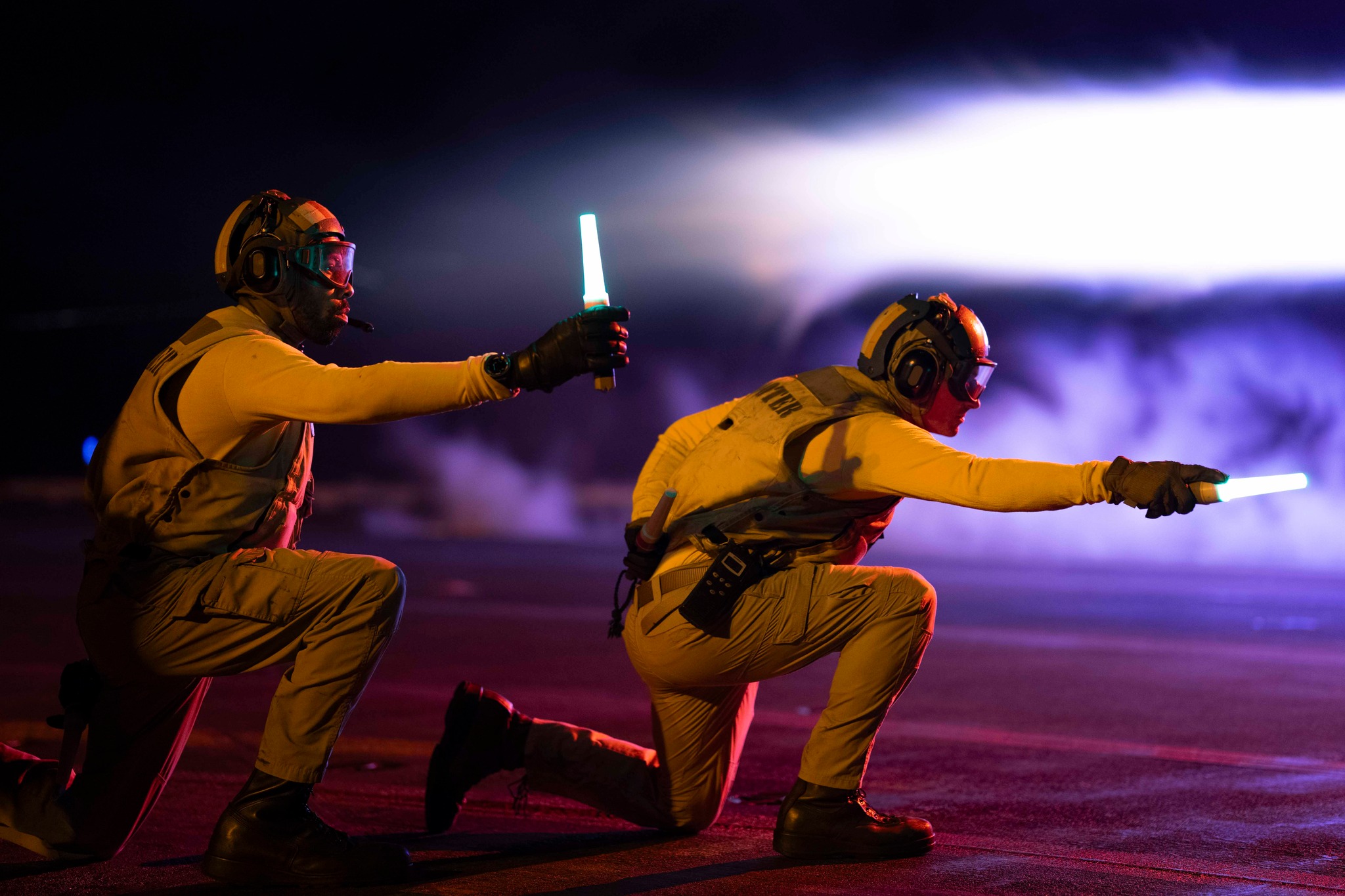
Q: Your surface combatant escorts did an amazing job all the way around. What were some of the most memorable things you saw as they performed what had to be an incredibly stressful job being attacked themselves fairly regularly and protecting the carrier and the strike group and all the merchant vessels?
A: From the aircraft carrier perspective, our main battery is to get the jets off the deck and also the Hawkeye to provide the command and control. So in order for that entire process to happen – long story short – I need my catapults to work. I need my flight deck personnel to preposition the aircraft. If it’s not during normal flight ops. I need to make sure that the alerts are manned, set, and ready. So when we call it away, we can put a person in the cockpit and then fly.
Watching that whole process is also the upload of the weapons. We have to assume that if you’re setting alert, you don’t know what the threat is going to be exactly. So you have to have a mixed package of weaponry and make sure that the whole process works, which it did. And like I said, we had many instances of making that happen and then getting them out there. But again, a lot of this also relies on defense-in-depth, having multiple ships out there, radars on-station, and exquisite intel to give us heads up so we can make this happen. And that process worked.
Q: The carrier strike group participated in defending against the first direct Iranian attack on Israel. What role did you play and that must’ve been a wild twist in a large number of ways?
A: So for that large attack, all I can say is that we did participate in some way. Just our mere presence in the Red Sea prevents missiles from being the pathway, if you will, to Israel. So that was part of it. There were ships that were providing defense to Israel directly in the eastern Med. And so we were pre-positioned to support them the best way we could. That was the role we played.
Q: Are you able to talk about the use of SM-3 at all? It was the first combat use of that weapon.
A: I think that what you just said is what needs to be said and it was effective.
Q: The whole thing was pretty historic.
A: Yeah, pretty historic. And we’ve talked about that fact a lot. Nine-month deployment, it was supposed to be seven, six and a half months spent in the Red Sea and the sailors performed admirably. But when this happens, you sort of have to sustain it. You join the Navy to see the world. We didn’t get to see a lot of the world, go into port calls, which is the quintessential Navy thing. And we also go to port calls to do maintenance on the ship to fix things that can’t otherwise be done at sea. That eventually happened towards the end of deployment. And then the next part for us was, how can we make sure we adequately and rapidly reward the sailors for the good work that they did? So there’s a big effort to put in for various medals and other items to make sure that the sailors were amply rewarded. And I’ll tell you I probably signed 2,000 different types of awards for my own sailors. My crew is about 3,000, even though I have 5,000 on the ship, but 3,000 I’m directly responsible for and making sure they were rewarded and some people would say, ‘Hey, you know what? They were just doing their job,’ and yeah, they were doing their job, but they’re also doing their job without any knowledge of when they would go home for nine months in a threat weapons engagement zone. And they made things happen in combat to help save lives. So let’s reward them amply. And so we can work on things like retention and retaining sailors for the future.
Q: The carrier strike group expended a lot of munitions during this time. Can you talk about the challenge of expending so many munitions and at-sea replenishment?
A: There were some I can’t really talk to – the cruisers and destroyers. From the aircraft carrier perspective, we had onboard more than enough to handle even several more months at sea because of the huge size of an aircraft carrier. I mean, our weapons magazines, we could probably fit two ships inside them alone. So that wasn’t a concern, although we do worry about missile conservation. You don’t want to be doing this willy-nilly. So we always made sure that we were picking the right weapon for the right target so it would be more efficient that way. But at the end of the day after not considering all the strikes that we did to degrade their capability, when it comes to defending ships you expend what you need to save the crew. And I don’t think anybody disagrees with that.

Q: The first woman pilot to shoot down an enemy aerial threat happened to be on this deployment. Can you talk a little about that and anything about the pilot?
A: I really can’t, because I didn’t realize this until after the fact that this occurred. I’m not going to speak for the woman herself, but they would probably say, ‘Hey, we’re just doing our job’ and so we kind of make a big thing of it and that’s fine because it is inspiring to a lot of people, no doubt. But from her perspective, she probably felt she was just doing her job. We had a similar instance in 1998 during Operation Desert Fox. I was told that we had the first female to drop a bomb in combat, and this was a four-day operation against Saddam Hussein’s forces after he kicked out weapons inspectors. But at any rate, again, it’s one of those things that the media kind of discovered it after the fact. And for us, we’re just like, ‘Hey, she’s one of us. We’re all professionals.’
Q: How did you discover it?
A: Oh, I discovered it via social media. I saw someone else post something and I don’t know where they got the information.
Q: What did you think about when you saw that on social media?
A: Oh, I was like, you know what? I’m not surprised. Now, if you think about it, it wasn’t until 1994 that we allowed women to serve on combat ships. And in fact, the USS Dwight D Eisenhower was the first ship to allow women to serve on it. For a lot of the young sailors, it seems like so long ago. For me, this was in my lifetime. This was while I was in the Navy and I got to see that change. I was going through ROTC at Tufts University in 1994 and I remember the women in the unit were at MIT. They were pretty excited that they now had opportunities to serve in combat like the rest of us. So I joined at an age where it was just normal to be serving with women. This is what we do. And we fight together, we go down together. Right? And so it doesn’t really shock us, like it does to the outside world. You know what I mean?
Q: So for the crew, this was no big deal?
A: No. I mean, there is a pride, but it’s just expected at this point. I do tell my women sailors, I’m like, ‘hey, you guys take for granted that this, what we’re doing now is new. And I think a lot of you are in roles that probably a woman has never served in. It just, you didn’t realize it to now until now.’ Right. We had the first African-American reactor officer as a Navy captain on the ship. And she didn’t really want to talk about that either. Right. She just wanted to do her job excellently, which she did do, but that was a source of pride for a lot of junior sailors as well. So mixed emotions, but all positive at the end of the day.
Writing The Book On Morale
Q: We saw all types of new morale boosters from you and on your very popular social media account. From your sports bar-like area to Demo the support dog. How did you come up with all this and what worked and what didn’t? What do you think will be adopted Navy-wide?
A: So we looked at morale in sort of on a spectrum of options you can do to improve it. The theory is if I can improve morale, I’m going to have success in inspections, combat – people are going to care more. And it’s important to understand what morale is and is not. Morale is not necessarily happiness. Morale is something deeper. It’s spiritual. It’s about motivation. It’s highly tied to job satisfaction. That would be sort of like the civilian equivalent. ‘Do I like coming to work?’ Right? ‘Do I want to feel like a part of the work’s mission?’ So we first have to understand that. Step two is you have to get into, ‘hey, I have to make sure all leaders are loving and valuing their sailors.’ We cannot be afraid to use the word love and we have to show it. And I can give a whole menu, we don’t have time, of all the things you can do to show that you value sailors.
We have to make sure they understand mission and purpose. So discussing the mission. And then when they do something, you recognize it publicly that, ‘Hey, we just did our mission.’ And this kind of increases our sense of purpose and feel like we’re part of something greater than ourselves. So that’s the big picture. Now, what else can you do? Well, things like food, right? Food’s important. We take it for granted ’cause we have food and we get replenished almost every week when we’re out to sea. I know sailors still complain about the food. That’s normal. And I say, ‘Hey, why don’t you go on a submarine?’ Right. And then I, of course, now I just offended the submarine guys, because they are very good at utilizing the little amount of food that they do have. So there’s a lot of pride in that world, but food’s important. I mean, we had ice cream socials every single week, of course, taco Tuesdays, pizza on Saturdays, things that you could look forward to. And then resiliency is also tied to morale.
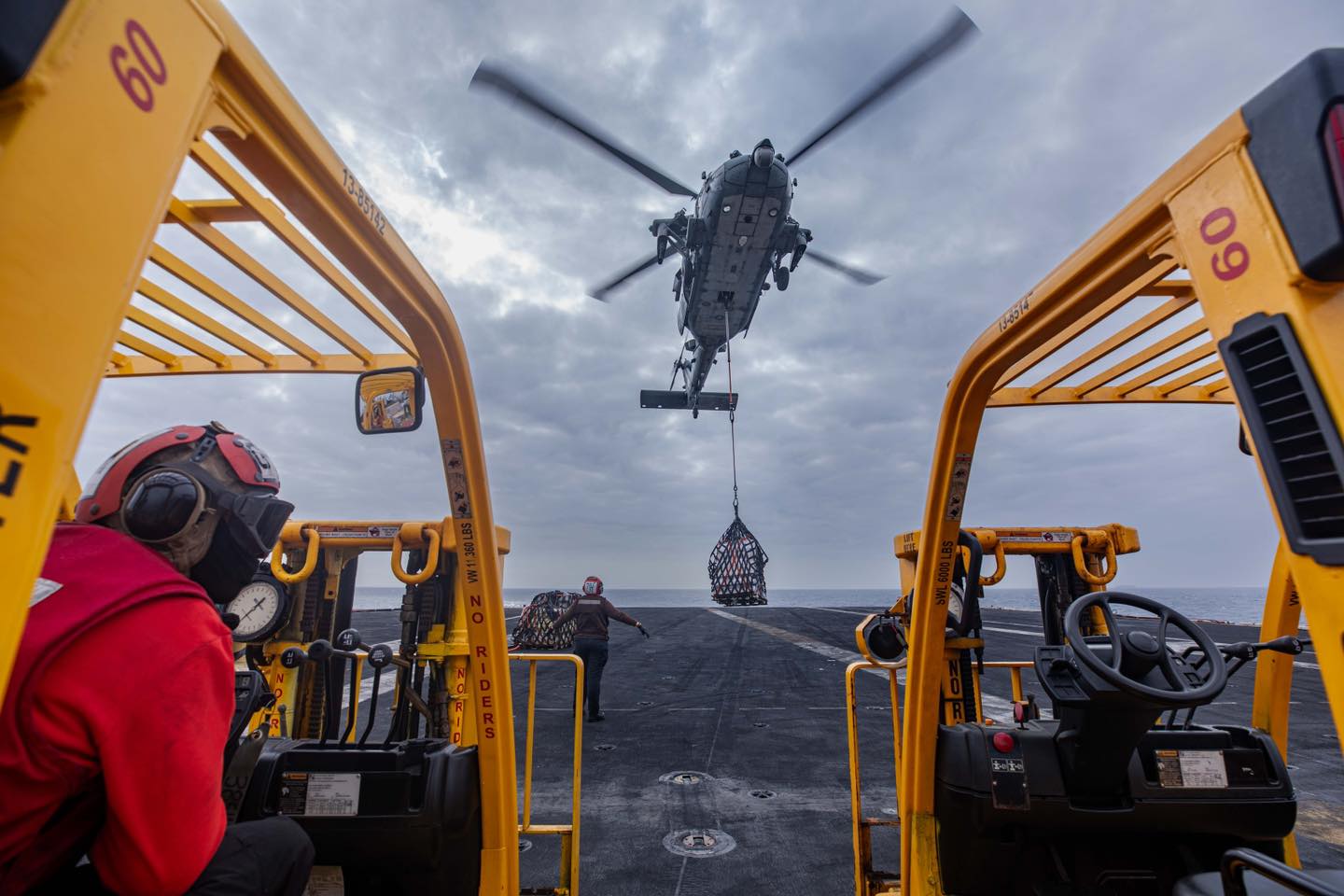
We added an additional licensed clinical social worker. We had a civilian-deployed resiliency counselor that could provide therapy. We had a psychologist. So if anyone’s having a tough time or they’re going through a crisis, there was someone there for them to talk to. And then you go to step three. It’s like, okay what what can people do on their limited free time? Well, how about we collaborate with the USO and we create a USO center? So they came in and we refurbished an entire space. It looks like a pub, but you can play video games. You can hold events there. People would reserve it just to have a function, if you will, maybe have a cake or birthday, whatever. We had the facility dog Demo, whose job is to – he’s trained to reduce stress. And Demo was my friend. We hung out several times. I gave him snacks. He put on 15 pounds on deployment. So we’re working on that right now.
And then finally, having the Wi-Fi. I don’t throw around the word game-changer a lot, but this was a game-changer. And why is it? It’s because this allowed people to near instantaneously when they needed to, on-demand, talk to their external support network, the people that care about you. I realize on the ship you’re still required to be loved and valued. And leadership has to do that. But it’s not the same as mom and dad or your spouse or your best friend and girlfriend or boyfriend to be able to talk to them, especially after nine months of deployment. With my 12-year-old, we were communicating via memes. Right. I guess that’s how you communicate. But it was great. I felt like I was connected every single day. And so I can’t really understate the value of that. But it was just amazing.
And then this also offered the opportunity to do social media. And so, I’m taking some risks here. We’re in an operational environment. Can I get out there and say, ‘here are the sailors and show pictures of them and do some goofy stuff just ’cause I’m a goofy person?’ I’m not going to change my personality. And so I did that. And I found very quickly that my account was discovered by moms and dads and spouses. And they wanted to see pictures of their sons and daughters and spouses. So I said, ‘Okay, I’ll bring them up to the bridge, give them a cookie. It’s a nice gesture. And then post that.’ And people were just ecstatic. And so then I started to get thousands of requests and I just could not keep up with it. But part of morale is sailor recognition. And we tried everything we could. We had a warrior of the day celebrated every day. We had the cookie sailor, which was requested by mom and dad, sailors of the quarter, sailors of the year for all the different departments had it as well.
Anytime I would get on the 1MC or the PA system, I would have people kind of feed me. ‘Hey, can you give a shout-out to so-and-so for doing this, that, and the other thing?’ And so I would just say people’s names. People love the sound of their own names, whether they say it or not. And then we go through that. So it’s just that’s kind of the spectrum of morale. A book should be written on it. I’m actually trying to write one. I just don’t have the time to get through it.
Q: What’s it going to be called?
A: Well, the philosophy, I call it ‘The Way of the Warriors Sailor.’ But I think there’s applicability to the civilian world, I think. I haven’t been a civilian for a long time, but so people tell me. So maybe it’ll just be called that and people can take what they can from it.
A: I look forward to reading it. Do you think any of these things will be adapted Navy-wide?
A: No, I don’t think it would. It’s just not how our system’s built. However, I have got the attention of some of the key people that matter to me, like the folks at our leadership schools – some of the leadership at the nuclear naval reactors, and they’re in charge of the nuclear sailors. And I think they need some of this, and I think it would help them and spread to other ships. They’re requesting feedback on what they can do better to teach it. I’ve also gotten requests from various entities in the U.S. Army and from Army leadership schools and that sort of thing. So I just feed them my philosophy. It’s like a little document, about 26 pages, and it goes over a lot of these items in more depth.
Q: What would you like to see adopted? What would be the most important thing you’d like to see happen?
A: Well, I think it’s important to go big and not be afraid to use terms like ‘to love and value,’ and then really understand what mission and purpose is, and truly understand what morale is. In naval regulations, the commanding officer is required to care about the morale of his people. But the thing is, we don’t really teach how to do that, right? A lot of our training is focused on ethics and character building, and that’s all important. But that next step is how do you transform an organization? What can I do? What can I say? That’s the kind of training I think we need to get a little bit more into. So I feel like people are listening, which is good. But again, I don’t make the decisions on these things. I’m just one guy.

Q: Talking about Wi-Fi and morale, did you follow the Navy Times story about the USS Manchester and the surreptitious Wi-Fi system that the chief’s mess installed?
A: Yeah, so there are some pitfalls in going this alone. And I think those articles address some of these issues. Like if you’re going to install a Wi-Fi system, there needs to be controls in place for security purposes to monitor some of the traffic, to be able to turn it off instantly if you have to, for whatever reason, to save the ship. And I would presume, and I don’t know the full story behind it, but this cannot be done willy-nilly. And I think that was part of the issue with that one.
Q: Is an antenna on your ship that you don’t know about a security threat?
A: I would think so. But if you think about it – I’m not a computer guy, right? There is a PII, Personally Identifiable Information. So potentially someone can hack into that and get into your phone, I guess. That could be a problem. But it’s not connected to the ship system. So I don’t think there’s any threat there. But it’s something we have to be cognizant of. Sometimes you have to turn it off.
Q Could it be a beacon for adversarial signals intelligence?
A: Oh, yeah, for sure. It could be a beacon. So that’s why there are instances where you have to shut it off. And it has to be centrally controlled and part of a process. So that’s absolutely correct.
Q: What was your biggest takeaway on leadership after captaining one of the world’s most powerful warships during a time of combat?
A: Well, the first thing is you can’t please everybody, right? Despite the best efforts of all my leaders to follow the way of the warrior sailor – and they were believers in it – there were setbacks. And some people don’t buy into it. Some people could have pre-existing conditions or mental health issues that just kind of take over. We can’t control the morale of what happens at home. That’s the second problem. You could be going through a divorce or you could be getting dumped by a girlfriend or something. Those things I can’t control. And those are high morale issues. But we can control what we can control.
And then, of course, the enemy has a vote, right? So they may say, you know what, the enemy decides that we’re not going to do a port call for six and a half months. And that’s just the way it’s going to have to be. And that’s kind of what we dealt with. And that’s fine. We could go indefinitely. It’s just a nice thing to have to decompress once in a while. So dealing with that. All that built-up morale credit could slowly disappear if you don’t fight for it. So constantly staying positive, constantly doing your basic principles of recognizing sailors because you love and value them, constantly reminding them of their mission and purpose and that every single sailor matters in the mission. And sometimes you have to repeat it over and over because there were times when security sailors would come up to me, ‘Sir, you never talk about security enough.’ And I said, ‘I talked about you guys last week,’ right? So I need to do the repetition thing, rapid, repetitive, relentless, positive communications, R3P is what I call it. It’s hard for me to say the three R’s in a row.
Q: Any takeaways from this deployment that you think might be applicable to a high-end fight against China?
A: Yeah. Some of the logistical challenges, the resiliency challenges, and some of the stuff we learned with regard to drones and missiles. I think all of it is applicable in a future fight. And that’s the kind of lessons learned we’re already sharing. And everyone agrees on that.
Q: Taco Tuesdays aboard the Ike became famous thanks to your tweets about them. What is the Chowdah Hill go-to taco on Tuesdays?
A: I am so old school, low-budget guy. I’ll take a plain old taco shell with some plain old meat with the mix on it to make it taste like taco meat. And a little bit of cheese, maybe a little sour cream and lettuce, boom, done. Right. Very simple. I don’t go crazy on that stuff. Just keep it simple.
Q: Anything I haven’t asked you, anything that I should, anything you’ve never talked about that you’re dying to talk about because you’ve been asked a lot of questions?
A: No. I do end up talking a lot about leadership stuff to people. And I’m saying a lot of the same things. One of the things I do say is what I’m saying about leadership is nothing new, right? I went to the U.S. Naval Institute’s proceedings website with articles going back more than a hundred years. I typed in the word morale and what came up were articles written as far back as World War I saying some of the same stuff I’m saying now. So when I talk about loving and valuing people, maybe I’m taking an extra step in language. A lot of times we get stuck in terms like, ‘hey, we must have dignity and respect for each other.’ I agree with that, but how about we take it to the next step, actually love people? I think we’re at a day and age where we could use a little extremism when it comes to leadership.
And then the other part that bothers me is that many assumptions, sometimes wrong, are made about generational differences. And that bugs me. There is a generational bias that has existed for thousands of years. You can read Aristotle talk about it. You can read about pre-World War II. ‘Hey, this generation they’re disrespectful.’ And then they end up doing what they did in World War II. And then we see it, we start with the millennials 15 years ago, I’m going through training. They said, ‘you know what, this generation, they’re really addicted to technology and social media.’ And they always want to know why. And I said, ‘well, hey, I wanted to know why too, right? And we’re the ones that invented the technology.’ Actually it was the Baby Boomers. So we just kind of made it better and then the millennials made it even better, right? But the fundamental chemistry of the human brain has not changed in a hundred thousand years, nor has good leadership, right? So if people come up to you and say, ‘Hey, this is new school,’ or ‘I believe in old school leadership,’ the question mark appears above my head and I say, ‘No, I’m old school. I have Caesar, Napoleon, Moltke, Eisenhower all backing me up that this is the right way.’
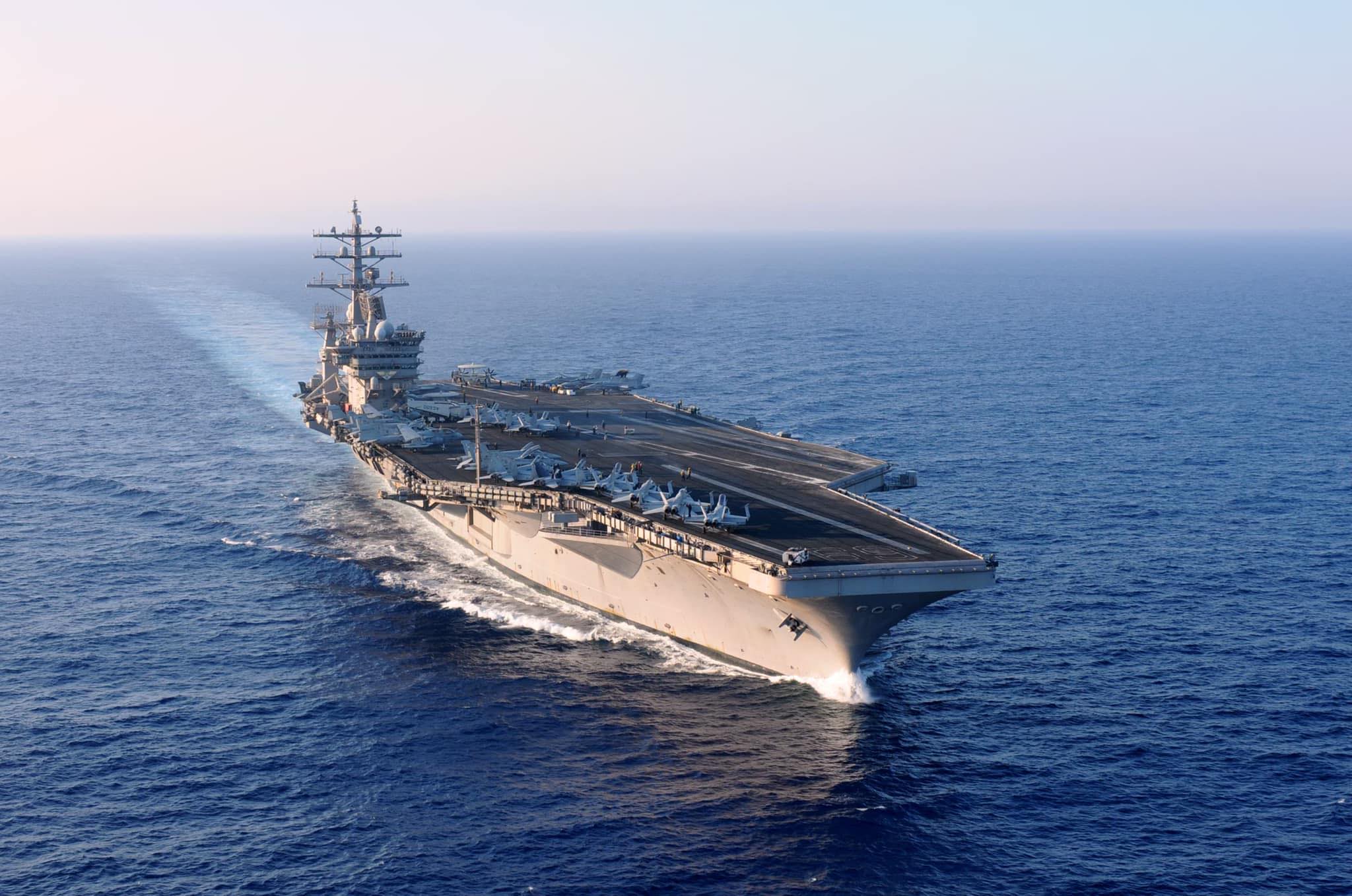
Q: What will you miss most when you hang up your uniform?
A: Oh, I love the people. I love working with junior people, junior sailors, junior officers. I love telling the stories and I love to see the spark in their eye when they feel like they have mission and purpose and it’s so easy to give it to them because a lot of people say they joined the Navy just because I needed college money. I’m like, yeah, that’s one of the reasons why you join, but you also join to serve, to wear a uniform, to practice salutes in a mirror, which they get a laugh when I say that, because they all did it. And to be part of something greater than yourself, right?
So those are the kinds of words it’s almost too cool to say. So you don’t say it, but you can tap into that as a resource by reminding them that they have that inside them. That is the original source of their morale. I don’t know the word for that, but I want to get after that. And I say to them, ‘some day you’ll be 80, 90 years old, and you’ll be talking about when I was on the Ike, it was an old ship, and talk about what they went through, but they’re going to talk with pride about their experience. So I just have to give them that story for later on in life.
Contact the author: howard@thewarzonecom
